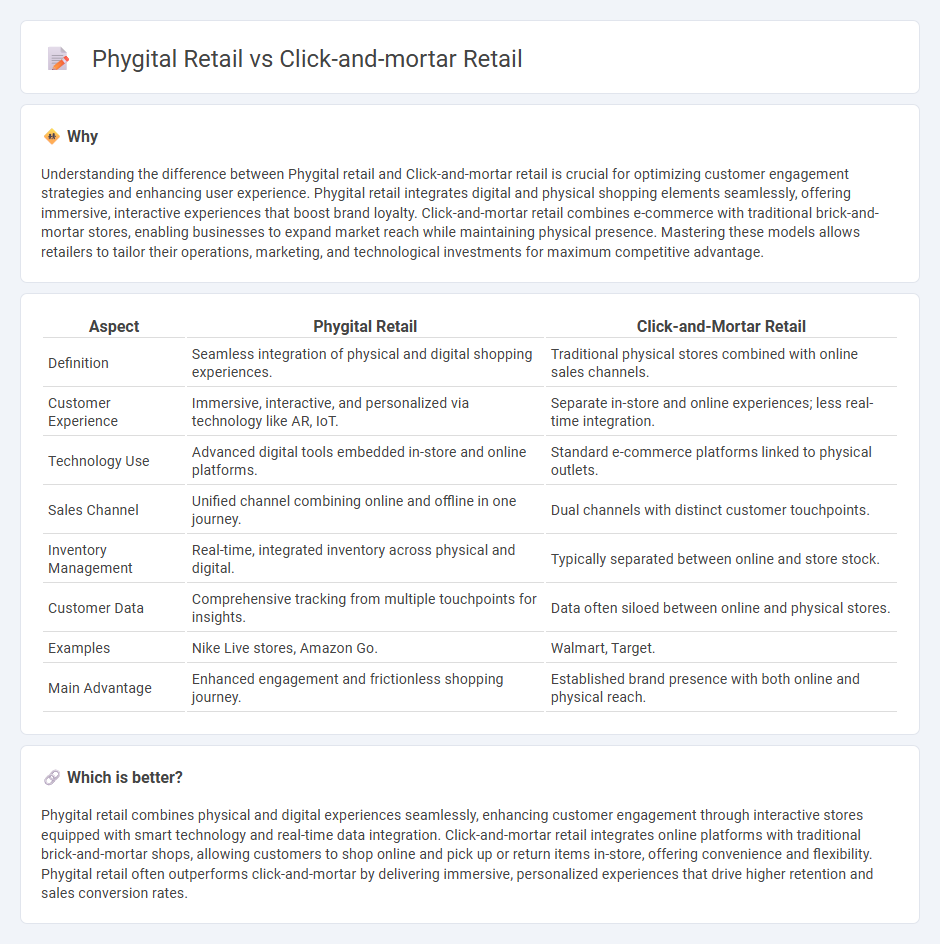
Phygital retail combines physical and digital shopping experiences to create seamless customer interactions through technologies like augmented reality and mobile apps. Click-and-mortar retail integrates online storefronts with brick-and-mortar locations, enabling consumers to shop digitally with options for in-store pickup or returns. Explore how these innovative retail models are transforming consumer behavior and business strategies.
Why it is important
Understanding the difference between Phygital retail and Click-and-mortar retail is crucial for optimizing customer engagement strategies and enhancing user experience. Phygital retail integrates digital and physical shopping elements seamlessly, offering immersive, interactive experiences that boost brand loyalty. Click-and-mortar retail combines e-commerce with traditional brick-and-mortar stores, enabling businesses to expand market reach while maintaining physical presence. Mastering these models allows retailers to tailor their operations, marketing, and technological investments for maximum competitive advantage.
Comparison Table
| Aspect | Phygital Retail | Click-and-Mortar Retail |
|---|---|---|
| Definition | Seamless integration of physical and digital shopping experiences. | Traditional physical stores combined with online sales channels. |
| Customer Experience | Immersive, interactive, and personalized via technology like AR, IoT. | Separate in-store and online experiences; less real-time integration. |
| Technology Use | Advanced digital tools embedded in-store and online platforms. | Standard e-commerce platforms linked to physical outlets. |
| Sales Channel | Unified channel combining online and offline in one journey. | Dual channels with distinct customer touchpoints. |
| Inventory Management | Real-time, integrated inventory across physical and digital. | Typically separated between online and store stock. |
| Customer Data | Comprehensive tracking from multiple touchpoints for insights. | Data often siloed between online and physical stores. |
| Examples | Nike Live stores, Amazon Go. | Walmart, Target. |
| Main Advantage | Enhanced engagement and frictionless shopping journey. | Established brand presence with both online and physical reach. |
Which is better?
Phygital retail combines physical and digital experiences seamlessly, enhancing customer engagement through interactive stores equipped with smart technology and real-time data integration. Click-and-mortar retail integrates online platforms with traditional brick-and-mortar shops, allowing customers to shop online and pick up or return items in-store, offering convenience and flexibility. Phygital retail often outperforms click-and-mortar by delivering immersive, personalized experiences that drive higher retention and sales conversion rates.
Connection
Phygital retail integrates physical and digital shopping experiences, allowing customers to interact seamlessly through online platforms and in-store technology. Click-and-mortar retail combines e-commerce capabilities with traditional brick-and-mortar stores, enabling businesses to leverage both channels for increased customer engagement and sales. Both models emphasize omnichannel strategies to provide a cohesive, convenient experience that bridges online convenience with tactile in-store benefits.
Key Terms
Omnichannel
Click-and-mortar retail integrates physical stores with online platforms, enabling seamless customer experiences across channels, while phygital retail enhances this by blending physical and digital interactions in real time through technologies like augmented reality and IoT. Both models leverage omnichannel strategies to unify inventory, marketing, and customer service, ensuring consistent engagement whether shopping online or in-store. Explore the latest advancements in omnichannel retail to maximize customer satisfaction and operational efficiency.
Customer Experience
Click-and-mortar retail combines online convenience with physical store presence, enhancing customer experience through seamless integration of digital and in-store services. Phygital retail takes this integration further by using advanced technologies like augmented reality, AI-driven personalization, and IoT-enabled smart displays to create immersive, interactive shopping environments. Explore how these innovative approaches transform consumer engagement and satisfaction in modern retail.
Integration
Click-and-mortar retail combines traditional brick-and-mortar stores with online shopping platforms, offering consumers convenience and varied purchasing options through partially integrated sales channels. Phygital retail takes integration further by seamlessly blending physical and digital experiences using technologies like augmented reality, IoT sensors, and personalized mobile apps to enhance customer engagement and streamline operations. Explore how businesses leverage advanced phygital integration to transform retail experiences and drive innovation.
Source and External Links
How to leverage Clicks and Mortar for retail - Lightspeed - Click-and-mortar (or clicks and mortar) is a retail model that integrates physical stores with digital channels, offering customers both in-person shopping and online options such as ordering online with in-store pickup, unified inventory, and seamless pricing to provide a consistent and flexible experience across channels.
What Is Click and Mortar? How Do They Work? - Shopify - Click-and-mortar is an omnichannel retail strategy merging brick-and-mortar locations and online platforms to streamline shopping by letting customers buy in person or online, enhancing convenience, customer satisfaction, and competitiveness.
Click and Mortar: Definition, Advantages & Disadvantages - This model integrates online and offline retailing to allow customers flexibility to start a purchase in one channel and complete it in another, evolving as a response to competition from online marketplaces by leveraging physical stores as competitive assets.
 dowidth.com
dowidth.com